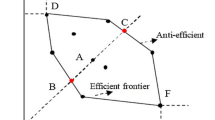Abstract
As is known that there are some drawbacks bid evaluation decision for some major projects, which would easily induce some problems, such as fault decision, low efficiency, poor benefit, etc., or even some social corruptions, which would seriously affect the cooperation and sustainable development of society, economy and environment. Therefore, considering these drawbacks, in this paper, a new model based on analytic hierarchy process and data envelopment analysis (AHP/DEA) cross-efficiency is proposed for bid evaluation decision problems of major project. To deal with the complexity of bid evaluation decision for major project, a set of indices with multiple inputs and outputs is firstly proposed. Then, the DEA cross efficiency is adopted to develop a pairwise comparison matrix, after that, the AHP is applied for bid evaluation decision for major project using the pairwise comparison matrix. Finally, case studies are presented to demonstrate the reasonability and feasibility of the proposed evaluation decision model, it follows from these results that, the proposed new bid evaluation decision model can shed some new light on contractor selection for major projects.



Similar content being viewed by others
References
Charnes A, Cooper WW, Rhodes E (1978) Measuring the efficiency of decision making units. Eur J Oper Res 12(6):429–444
Chen M (2017) Quality influencing factors and project quality control in municipal engineering construction. East China Sci Technol 4:394–407
Cook WD, Seiford LM (2009) Data envelopment analysis (DEA)-thirty years. Eur J Oper Res 192(1):1–17
Du T et al (2017) Organization multi-attribute decision making based on efficiency and its empirical research: DEA-TOPSIS combination method. Chin Manag Sci 7:153–162
Fu J (2015) Research and application of DEA model based on AHP. Metall Autom:530–531
Guo J, Liu J, Qiu L (2006) Research on supply chain performance evaluation based on DEA/AHP model. In: IEEE Asia-Pacific conference on services computing, pp 609–612
Hatush Z, Skitmore M (1998) Contractor selection using multi-criteria utility theory: an additive model. Build Environ 33(2–3):105–115
He M et al (2000) Application research of DEA in engineering bidding. J Shandong Univ Sci Technol 19(1):115–119
Hiyassat AS (2001) Construction bid price evaluation. Can J Civ Eng 8(2):264–270
Li C (2014) The study on the evaluation model of DEA cross-efficiency and fuzzy comprehensive assessment in decision making for bidding of construction projects. Adv Mater Res 4:986–993
Li C, Su H, Tong Y, Sun Y (2015) DEA cross-efficiency evaluation model by the solution strategy refering to the ideal DMU. Chin J Manag Sci 23(2):117–120
Lin Y, Wang Y, Chen L (2018) DEA evaluation method based on cross ranking of decision making unit. J Zhejiang Univ 45(2):162–168
Liu E, Wang J, Luo G (2003) Project bidding decision-making method based on fuzzy logic. J Civ Eng 36(3):57–63
Liu C, Hsu H, Wang S, Lee H (2005) A performance evaluation model based on AHP and DEA. J Chin Inst Ind Eng 22(3):243–244
Liu M et al (2013) Research on bidding decision of engineering project based on DEA model. Proj Manag Tech 12(1):63–66
Peng K, Qiang M (2004) Research on the application of fuzzy analytic hierarchy process in risk assessment and bidding decision of Duber Khwar project. J Hydroelectr 23(3):44–50
Sexton TR, Silkman RH, Hogan AJ (1986) Data envelopment analysis: critique and extensions. Jossey-Bass, San Francisco
Turkis Z (2008) Multi-attribute contractors ranking method by applying ordering of feasible alternatives of solutions in terms of prefer ability technique. Technol Econ Dev Econ 14(2):224–239
Wang L, Xing W (2006) Research on supplier selection based on fuzzy analytic hierarchy process. Mall Mod 16:111–112
Wu L et al (2004) A new method of government procurement evaluation-comprehensive weighted average price difference method. J Shenyang Univ Technol 26(5):173–180
Yang F (2011) DEA cross Efficiency evaluation method for competitive and cooperative decision making units. Syst Eng Theory Pract 33(1):92–95
Yang X, Liu C (2010) It is urgent to strengthen social stability risk assessment of major projects. Curr Obs 10:32–36
Yuan J (2000) Research on the model and method of construction bidding. China Highw J 13(1):27–30
Zhang Y, Wang X (2014) Research on tender evaluation method for engineering projects based on two -stage model of DEA/AHP. Math Pract Theory 44(18):53–54
Author information
Authors and Affiliations
Corresponding author
Additional information
Publisher's Note
Springer Nature remains neutral with regard to jurisdictional claims in published maps and institutional affiliations.
Rights and permissions
About this article
Cite this article
Zhao, L., Liu, W. & Wu, Y. Bid evaluation decision for major project based on analytic hierarchy process and data envelopment analysis cross-efficiency model. J Ambient Intell Human Comput 11, 3639–3647 (2020). https://doi.org/10.1007/s12652-019-01564-z
Received:
Accepted:
Published:
Issue Date:
DOI: https://doi.org/10.1007/s12652-019-01564-z




